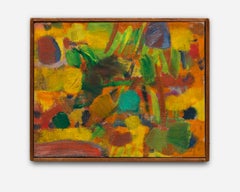Fred Mitchell On Sale
Recent Sales
Mid-20th Century Abstract Expressionist Abstract Paintings
Canvas, Oil
Fred Mitchell for sale on 1stDibs
Fred Mitchell is included in the book New York School Abstract Expressionists. He was an important New York City artist in the ‘50s and ‘60s. Mitchell was born in Mississippi and was known as a gifted Abstract Expressionist painter. In 1943, Mitchell was drafted into the US Army. After the war, Mitchell attended Cranbrook Academy for two years where he further studied and practiced an advanced Modernist/Regionalist style of painting. After some travel around Europe, Mitchell settled in Rome for three years. There he met several American painters including Angelo Ippolito and John Heliker, who were older and working in a more advanced Expressionist painting style. This made a large influence on Mitchell's work. In 1951, Mitchell moved to New York City and became one of the first painters to open a painting studio in downtown Manhattan. Mitchell started an art school in the old Seaman's Church Institute in the seaport area along the East River known as Coenties Slip. Coenties Slip consisted of old, large, and cheap cold water lofts. During the ensuing years, other artists moved nearby including Ellsworth Kelly (introduced to the area by Mitchell in 1954), Robert Indiana, Agnes Martin, Jack Albert Youngerman and James Rosenquist. Mitchell's first New York solo show was at Tanager Gallery in 1952 with solo exhibitions also in 1954 and 1960. Over its 10 year history, Tanager Gallery showed most of the best painters and sculptors including older masters Philip Guston, Adolph Frederick Ad Reinhardt, Willem De Kooning, Franz Kline, Barnett Newman, Philip Pavia and became an important platform for showing and introducing many new artists including early showings by Jasper Johns, Milton Ernest Robert Rauschenberg, Tom Wesselmann, Alex Katz, Philip Pearlstein, Bill King, Helen Frankenthaler, Norman Bluhm and many others. In 1954, Mitchell's oil painting, Black White and Red, was included in the landmark Guggenheim Museum show, 'Younger American Painters'. Curated by James Johnson Sweeney, the exhibition traveled to the Dallas Museum of Art and Detroit Museum. In 1953 and 1954, Mitchell was included in the prestigious, 'Stable Gallery Annual Exhibition'. In 1955, Mitchell returned to Cranbrook Academy to teach for several years while also exhibiting in New York and Cleveland as well as traveling back to Positano, Italy. During the mid to late 50s, Mitchell exhibited at Howard Wise Gallery in Cleveland. Wise opened a second gallery in 1960 in New York City, and Mitchell had two solo shows there.
Finding the Right Abstract-paintings for You
Bring audacious experiments with color and textures to your living room, dining room or home office. Abstract paintings, large or small, will stand out in your space, encouraging conversation and introducing a museum-like atmosphere that’s welcoming and conducive to creating memorable gatherings.
Abstract art has origins in 19th-century Europe, but it came into its own as a significant movement during the 20th century. Early practitioners of abstraction included Wassily Kandinsky, although painters were exploring nonfigurative art prior to the influential Russian artist’s efforts, which were inspired by music and religion. Abstract painters endeavored to create works that didn’t focus on the outside world’s conventional subjects, and even when artists depicted realistic subjects, they worked in an abstract mode to do so.
In 1940s-era New York City, a group of painters working in the abstract mode created radical work that looked to European avant-garde artists as well as to the art of ancient cultures, prioritizing improvisation, immediacy and direct personal expression. While they were never formally affiliated with one another, we know them today as Abstract Expressionists.
The male contingent of the Abstract Expressionists, which includes Jackson Pollock, Willem de Kooning and Robert Motherwell, is frequently cited in discussing leading figures of this internationally influential postwar art movement. However, the women of Abstract Expressionism, such as Helen Frankenthaler, Lee Krasner, Joan Mitchell and others, were equally involved in the art world of the time. Sexism, family obligations and societal pressures contributed to a long history of their being overlooked, but the female Abstract Expressionists experimented vigorously, developed their own style and produced significant bodies of work.
Draw your guests into abstract oil paintings across different eras and countries of origin. On 1stDibs, you’ll find an expansive range of abstract paintings along with a guide on how to arrange your wonderful new wall art.
If you’re working with a small living space, a colorful, oversize work can create depth in a given room, but there isn’t any need to overwhelm your interior with a sprawling pièce de résistance. Colorful abstractions of any size can pop against a white wall in your living room, but if you’re working with a colored backdrop, you may wish to stick to colors that complement the decor that is already in the space. Alternatively, let your painting make a statement on its own, regardless of its surroundings, or group it, gallery-style, with other works.
